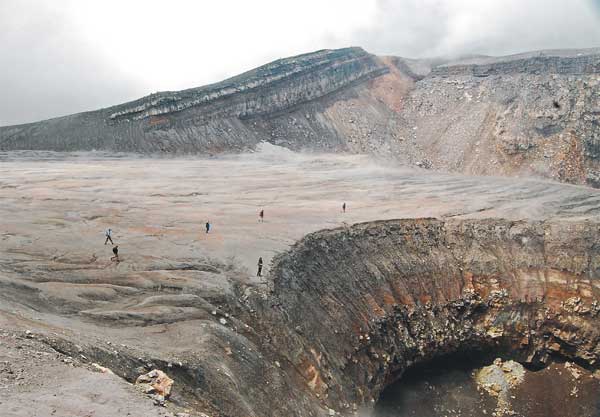
Expedition Explores Violent Russian Volcanoes

A group of scientists is hiking in one of the most remote areas on the planet in pursuit of new information about the recurring deaths and rebirths of two volcanoes.
The European expedition is spending two weeks on the Kamchatka Peninsula, a vast, isolated region of the Russian Far East that is home to one of the most active volcanic areas in the world.
The expedition, which runs to Sept. 7, is focused on the Mutnovsky and Gorely volcanoes, peaks just 9 miles (15 kilometers) apart that have been active for as long as 800,000 years. Both mountains have undergone repetitive destructive and rebuilding episodes. [See pictures from the expedition.]
Historically, such vigorous volcanic activity has made in-depth study of the region difficult. The team is collecting samples of hardened lava to try to determine the years of their self-destructive blasts.
Kamchatka's smoldering peaks are a part of the Pacific Ring of Fire — intermittent chains of volcanoes that encircle the Pacific Ocean. Over the last 6 million years or more, the area has experienced more explosive eruptions than any other region on Earth.
When volcanoes experience a particularly forceful explosion, they can eject all the magma inside them and immediately below them. "That leaves a void there, and the volcano gravitationally collapses inward," said Lee Siebert, director of the Smithsonian Institution's Global Volcanism Program.
What is left behind is called a caldera — essentially a massive crater, Siebert told OurAmazingPlanet. Over time, magma bubbling up from inside the Earth rebuilds the volcano, and the process begins all over again.
Sign up for the Live Science daily newsletter now
Get the world’s most fascinating discoveries delivered straight to your inbox.
But scientists don't know exactly when these processes occurred in the case of the two Russian volcanoes.
"The date of the big destructive event that initiated the new Gorely is something of a mystery," said the University of Quebec's Agnes Samper, who is a member of the expedition, which began Aug. 24.
"Previous studies using other techniques have given contradictory ages. Gorely has been through three cycles of being built up and then destroyed in massive explosions, and Mutnovsky has been through four. We will be using dating techniques based on natural radioactive decay to pin down accurate ages for these events that have built Mutnosvky and Gorely into the volcanoes that we see today," Samper added.
The team is collecting samples from hardened lava flows around the site, to be brought back to their laboratories for radioactive dating. Samples will be tested for levels of radioactive potassium, which is found in minerals in the rock. The potassium decays over millennia into the gas argon, which becomes trapped in the crystalline structure of the rock.
So far, Samper said, radioactive dating for the area has measured carbon-14 in coal formed from the vegetation burnt by lava during eruptions, but that method limits study to the past 40,000 years.
"By measuring potassium and argon, we can work directly with the volcanic rocks, giving us the age of the lava the moment it reached the surface — thus the date of the eruption," Samper said.
During the two-week trip, the team is hiking on foot to find fresh, unweathered samples of solidified lava flows from the slopes, tops and foothills of both volcanoes.
Samper explained the team will need to sample 4 to 7 pounds (2 to 3 kg) of rock for each site it wishes to date, "which promises heavy backpacks to bring back to the camp every night. But we are confident that the long and strenuous hikes will not curb our enthusiasm to understand the complexity of the fascinating stories of the Gorely and Mutnovsky volcanoes."
The expedition is a part of the Europlanet Research Infrastructure program, a European Union-sponsored endeavor.
This article was provided by OurAmazingPlanet, a sister site to LiveScience.









